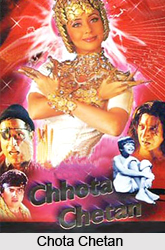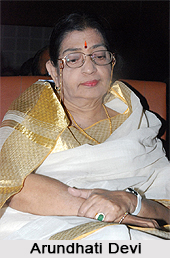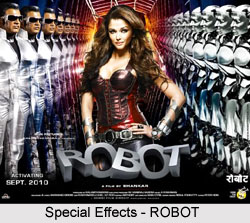 Special effects in Indian Films and their forms are also abbreviated as SFX, SPFX, or simply FX. These effects are actually the illusions used in the film industries to simulate the imagined events in a story.
Special effects in Indian Films and their forms are also abbreviated as SFX, SPFX, or simply FX. These effects are actually the illusions used in the film industries to simulate the imagined events in a story.
Special effects are conventionally separated into the categories of optical effects and mechanical effects. With the evolution of digital film-making tools a greater dissimilarity between special effects and visual effects has been noted, with "visual effects" that refers to the digital post-production and "special effects" refers to the on-set mechanical effects and in-camera optical effects.
The extended use of special effects in Indian cinema is difficult to guess since the genre is based on emotions unlike the universal practice of films, especially action and science-fiction films such as ET and Star Trek, which are entirely based on special effects.
Nowadays, many films start with the special effect casting and then start with the film. This creates the ambience of the film to follow. For example, a splash of blood on the screen is indicative of a murder mystery; the blood splash eventually takes the shape of the characters and thus set the mood for the film.
Filmmaker and actor Kamal Hassan is one of the innovative hands in the industry, who have always strived to introduce new aspects in filmmaking in India with the available technology and created special effects in his films. In his hand special effect gained diction. Prosthetic makeup, or the addition of skins to change facial contours, is an art form for creating special effects, extensively used by Kamal Hassan in films like Appu Raja, Chachi 420, Indian, Dasavatharam and many others. Kamal Hassan managed to convince his audience in the role of a dwarf, an elderly maid, an old man, a handicapped and so on, even without a single usage of computer-generated images or special computer technology. Kamal Hassan produced a film Abhay in which almost 50 per cent of the film`s budget was spent on special effects.
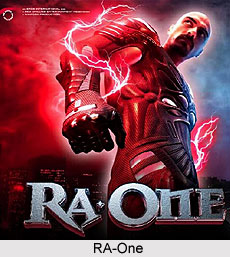 Lately, various highly proficient organizations in the special effects horizon have evolved in India. They are not only serving the Indian films but also working for some of the big production houses in Hollywood. The new millennium has many examples in Indian cinema with extensive use of special effects, such as Jodha Akbar, Krissh, Race, Koi Mil Gaya, Om Shanti Om, Tare Zameen Par, Rang De Basanti, Don - The Chase Begins Again, Dhoom, Dhoom 2, Kaante, Raaz and so on. Many film scripts have been written keeping in mind state-of-the-art special effects.
Lately, various highly proficient organizations in the special effects horizon have evolved in India. They are not only serving the Indian films but also working for some of the big production houses in Hollywood. The new millennium has many examples in Indian cinema with extensive use of special effects, such as Jodha Akbar, Krissh, Race, Koi Mil Gaya, Om Shanti Om, Tare Zameen Par, Rang De Basanti, Don - The Chase Begins Again, Dhoom, Dhoom 2, Kaante, Raaz and so on. Many film scripts have been written keeping in mind state-of-the-art special effects.
In the film Aks, there is a very special effect-cum-stunt of Manoj Bajpai and Amitabh Bachchan falling from a cascading waterfall. In a recently released film, Deham, Govind Nihalani has spanned across time in the use of digital special effects.
Some of the great examples of special effects (matte background) used in bollywood films are as follows:
* In the film Agent Vinod, actor Jagdeep "flies` around Mumbai with balloons in his hand.
* In Shashi Kapoor`s Ajuoba, "flying" carpets are seen. Amitabh Bachchan and Om Shivpuri fight in the "sky".
* In the film Don, Pran walks on a tight rope, crossing from one high-rise building to another, carrying two children.
* In the film Main Hoon Na, Shahrukh Khan runs behind a high-speed car with a rickshaw, also comes out unaffected from a blast.
* In the film Krishh, Hrithik Roshan flies all across the shooting location and also walks on the seas.
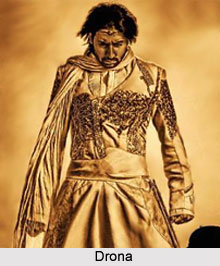 Sanjay Leela Bhansali`s Hum Dil De Chuke Sanam, is a film that was acclaimed for its special effects. In the scene of a kite-flying scene, the shooting was done with only four real kites and the others were all digitally created. In the last scene, where Aishwarya Rai and Ajay Devgan meet on the bridge, almost 250 fireworks in the sky are seen; each of these is a digital special effect. In the famous song Chand Chupa badal mein, the moon, clouds and stars are all created digitally. The art of special effects is to blend the natural and digital in a way that the audience will be blindfolded to the difference.
Sanjay Leela Bhansali`s Hum Dil De Chuke Sanam, is a film that was acclaimed for its special effects. In the scene of a kite-flying scene, the shooting was done with only four real kites and the others were all digitally created. In the last scene, where Aishwarya Rai and Ajay Devgan meet on the bridge, almost 250 fireworks in the sky are seen; each of these is a digital special effect. In the famous song Chand Chupa badal mein, the moon, clouds and stars are all created digitally. The art of special effects is to blend the natural and digital in a way that the audience will be blindfolded to the difference.
In Kaho Na Pyaar Hai, the scene where Hrithik Roshan dies underwater was superimposed on the computer. The scene was first shot in Bangkok, but the results were not satisfying. Before the advent of computers, these live underwater scenes were actually shot. Digitization has helped to a large extent to speed up and improve the art.
Special effects today offer a huge prospective to Indian cinema, since movies are probably the major form of entertainment available across the length and breadth of the country. Digital technology has brought many changes into the department of special effects in Indian cinema.
